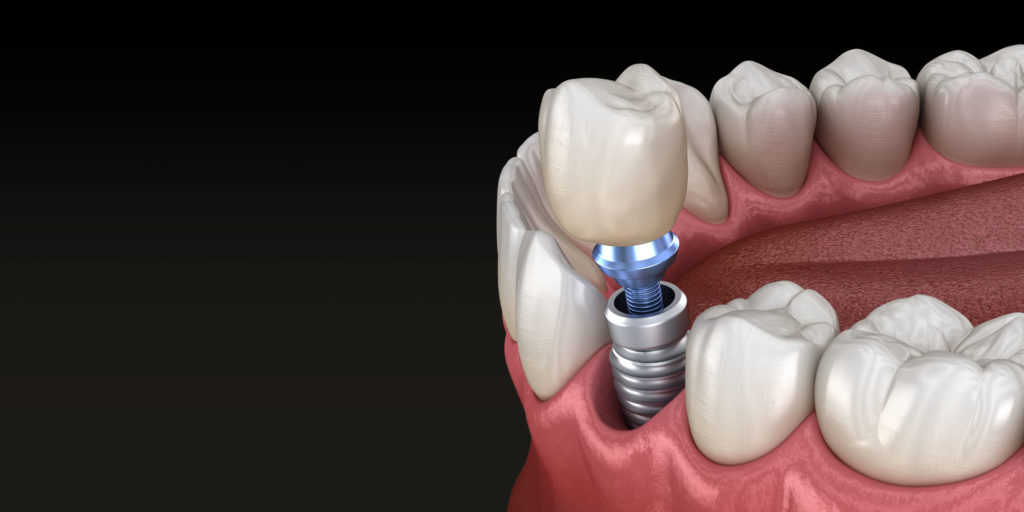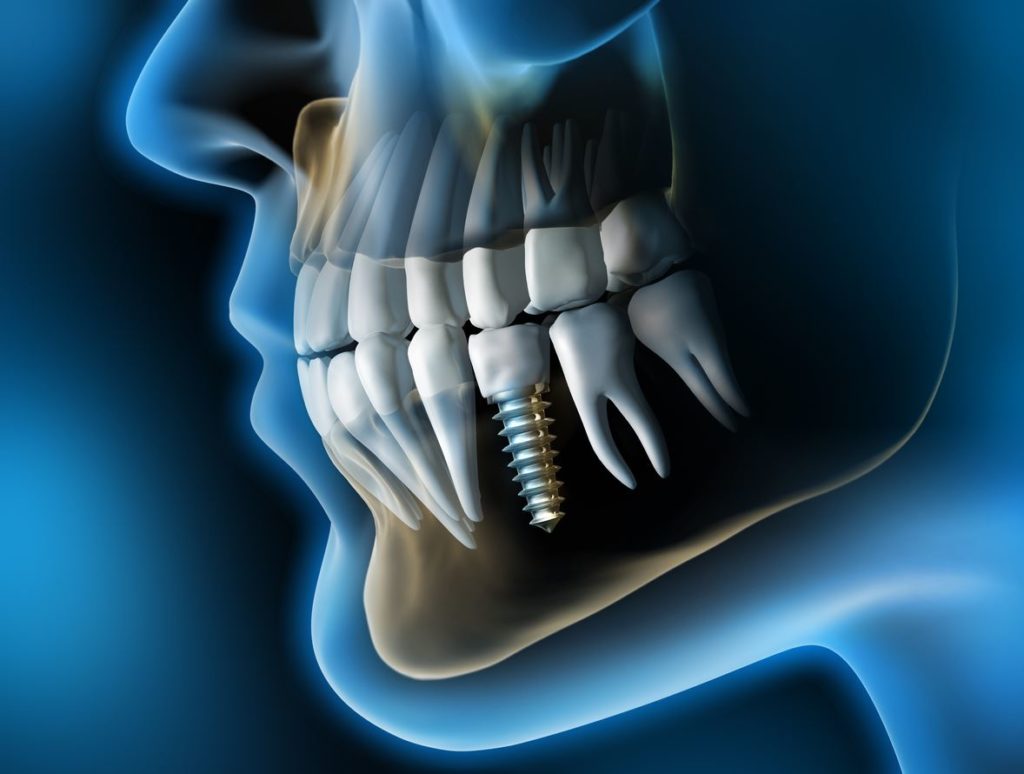What are Implants ?
Dental implants are artificial tooth replacements used to replace a missing tooth or teeth, helping to stop or prevent jaw bone loss.
By replacing missing tooth roots, implants offer more than an aesthetic enhancement, providing people with the strength and durability required to eat all the foods they love, with our struggling to chew. Although you have a number of restorative options for the treatment of missing teeth, none have proven to be as functionally effective and durable as implants.
In many cases, dental implants may be the only logical choice for the restoration of all necessary functionality of the teeth and supporting structures.
Implantology
The most important challenge for dentistry in the last 50 years is the use of implants.
The doctors in our clinic are very experienced and specialized, using different international recognized implant systems.
Why we need Implants ?
Once you lose a tooth, a replacement implant is recommended.
The teeth are lost because of:
- Tooth decay
- Root canal failure
- Gum disease (Periodontitis)
- Trauma to the mouth (tooth injury)
- Excessive wear and tear
- Congenital defects
People who have lost teeth might feel too self-conscious to smile or talk. Additionally, biting irregularities caused by tooth loss can have a negative effect on eating habits and this can lead to secondary health problems like malnutrition. Regardless of the nature of problems related to tooth loss, dental implants may provide a simple remedy with proven results.
What are Implants ?
Dental implants are artificial tooth replacements used to replace a missing tooth or teeth, helping to stop or prevent jaw bone loss.
By replacing missing tooth roots, implants offer more than an aesthetic enhancement, providing people with the strength and durability required to eat all the foods they love, with our struggling to chew. Although you have a number of restorative options for the treatment of missing teeth, none have proven to be as functionally effective and durable as implants.
In many cases, dental implants may be the only logical choice for the restoration of all necessary functionality of the teeth and supporting structures.
Working hours
Lorem ipsum dolor sit amet, consectetur adipiscing elit. Ut elit tellus consectetur.
Monday
09AM - 20PM
Tuesday
09AM - 20PM
Wednesday
09AM - 20PM
Thursday
09AM - 20PM
Friday
09AM - 20PM
Saturday
09AM - 20PM
Sunday
09AM - 20PM

Dental Implants Consultation and Treatment Planning.
To determine if implants are right for you the specialist dentist will conduct a thorough examination of your teeth and gums. This may involve a combination of X-rays and computer tomography scans (CT scans) to ensure that sufficient bone structure exists for placing the implant(s), and to determine the exact location the implant should be placed.
For single implants frequently we need only periapical x-ray or OPG x-ray which we will do directly in our clinic.
For multiple implantations or special anatomic situation we advice to make additionally an CT scan with a special splint so that we can use a 3 dimension software www.med3d.com in cooperation with our German implant specialized laboratory www.zahntechnik-online.de
Based on the condition of your oral tissues, oral hygiene and personal habits the dentist will advise you of your most appropriate dental implant treatment plan. Some patients with insufficient bone or gum tissue require bone or soft tissue grafts.
Your treatment plan could involve the immediate placement of an implant and restoration at the same appointment, or might require separate procedures to place the implant, allow healing and then place the restoration. In some instances, a series of procedures may be required to place tissue and bone grafting materials, allow time for healing, place the implant and allow it to integrate with your bone, and then place the restoration. Depending on your situation, the dentist will advise you of how long the entire treatment process will take, how many appointments will be necessary and what you can expect after each procedure.


The Dental Implant Procedure.
Implants are typically placed in a single sitting but require a period of osseointegration.
Osseointegration is the process by which direct anchorage of a dental implant root and the bone of the jaw occurs. Osseo integrated implants are the most commonly used and successful type of dental implant. An osseointegrated implant takes anywhere from three to six months to anchor and heal, at which point your dentist can complete the procedure with the placement of a crown.
Preparing the Jaw for Implantation:
A dental implant restoration is commonly composed of a titanium material screw and a crown. A small-diameter hole (pilot hole) is drilled at edentulous (where there is no tooth) jaw sites in order to guide the titanium screw that holds a dental implant in place. To avoid damaging vital jaw and face structures like the inferior alveolar nerve in the mandible (lower jaw), we use great skill and expertise when boring the pilot hole and sizing the jaw bone.
Placement of the Implant:
After the initial pilot hole has been drilled into the appropriate jaw site, it is slowly widened to allow for placement of the implant screw. Once in place, surrounding gum tissue is secured over the implant and a protective cover screw is placed on top to allow the site to heal and osseointegration to occur.
After up to six months of healing, we will uncover the implant and attach an abutment (which holds the crown or tooth-like replacement) to the implant. When the abutment is in place, we will create a crown or fix the denture on the implant.
Implant Surgery Follow-up Care
After the initial surgical procedure, discomfort should be minimal. Swelling of your gums and face may occur, as well as minor bleeding and bruising of the implant site. Prescription pain medications may be prescribed to relieve any pain or discomfort you feel after the procedure. For five to seven days after surgery, your diet should be restricted to soft foods. If stitches are present, they may need to be removed by your dentist; however, self-dissolving stitches that do not require removal are typically used.
The Dental Implant Procedure.
Implants are typically placed in a single sitting but require a period of osseointegration.
Osseointegration is the process by which direct anchorage of a dental implant root and the bone of the jaw occurs. Osseo integrated implants are the most commonly used and successful type of dental implant. An osseointegrated implant takes anywhere from three to six months to anchor and heal, at which point your dentist can complete the procedure with the placement of a crown.
Preparing the Jaw for Implantation:
A dental implant restoration is commonly composed of a titanium material screw and a crown. A small-diameter hole (pilot hole) is drilled at edentulous (where there is no tooth) jaw sites in order to guide the titanium screw that holds a dental implant in place. To avoid damaging vital jaw and face structures like the inferior alveolar nerve in the mandible (lower jaw), we use great skill and expertise when boring the pilot hole and sizing the jaw bone.
Placement of the Implant:
After the initial pilot hole has been drilled into the appropriate jaw site, it is slowly widened to allow for placement of the implant screw. Once in place, surrounding gum tissue is secured over the implant and a protective cover screw is placed on top to allow the site to heal and osseointegration to occur.
After up to six months of healing, we will uncover the implant and attach an abutment (which holds the crown or tooth-like replacement) to the implant. When the abutment is in place, we will create a crown or fix the denture on the implant.
Implant Surgery Follow-up Care
After the initial surgical procedure, discomfort should be minimal. Swelling of your gums and face may occur, as well as minor bleeding and bruising of the implant site. Prescription pain medications may be prescribed to relieve any pain or discomfort you feel after the procedure. For five to seven days after surgery, your diet should be restricted to soft foods. If stitches are present, they may need to be removed by your dentist; however, self-dissolving stitches that do not require removal are typically used.
Aftercare
Dental implant recovery depends on a number of factors, including the various procedures required to complete your treatment. However, it is generally recognized that once an implant has been placed, maintaining diligent oral hygiene habits is required to ensure proper fusing of the implant and bone structure. Failure to floss and brush is a leading cause of implant failure, and infection can occur if the implant and surrounding areas are not cleaned properly. Smoking also is attributed to high failure rates with dental implants and should be avoided following implant procedures.
Healing from the surgical procedure to place the dental implant(s) takes up to six months, while the fitting and seating of the crown(s) can take up to two months. Again, this timeframe depends on individual cases and treatments. Follow-up appointments with your treatment coordinators are essential for monitoring your progress. Additionally, even after the abutment and crown, bridge or implant-supported denture have been placed, routine follow-up appointments and cleanings still are required with us to ensure the longevity of your treatment.
If cared for properly, an implant restoration can remain in place for more than 40 years. It is generally recognized that once an implant has been placed, maintaining diligent oral hygiene habits is required to ensure proper fusing of the implant and bone structure. Failure to floss and brush is a leading cause of implants failure, and infection can occur if the implant and surrounding areas are not cleaned.

